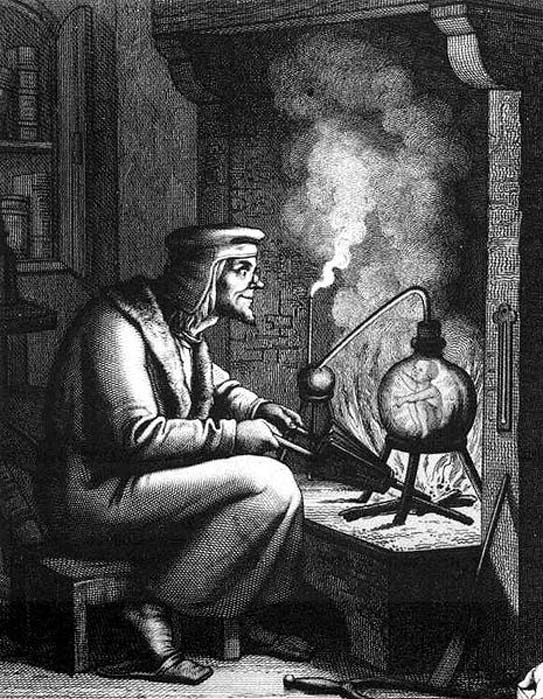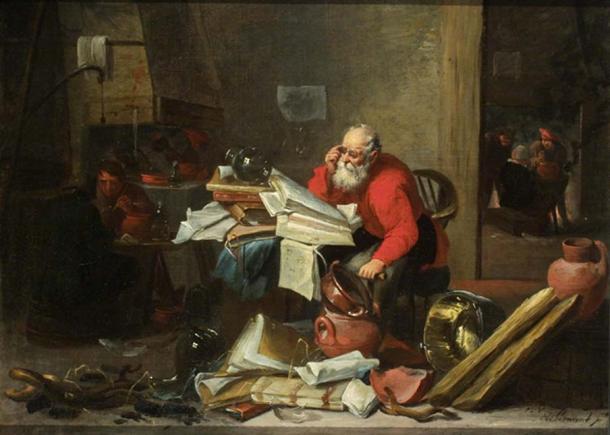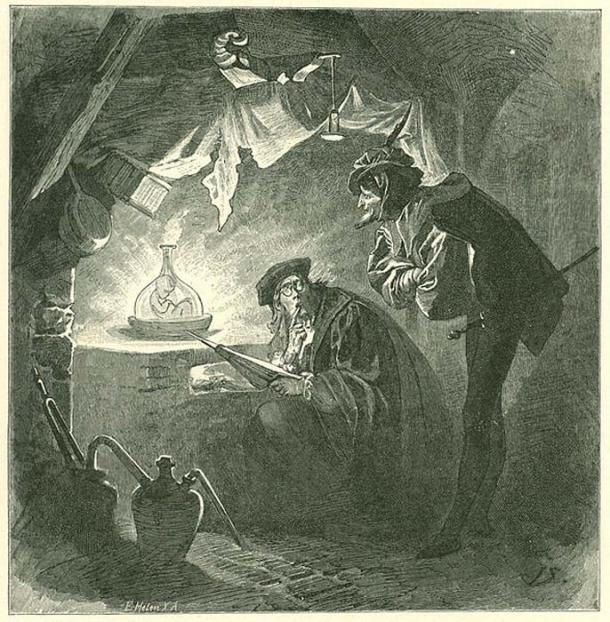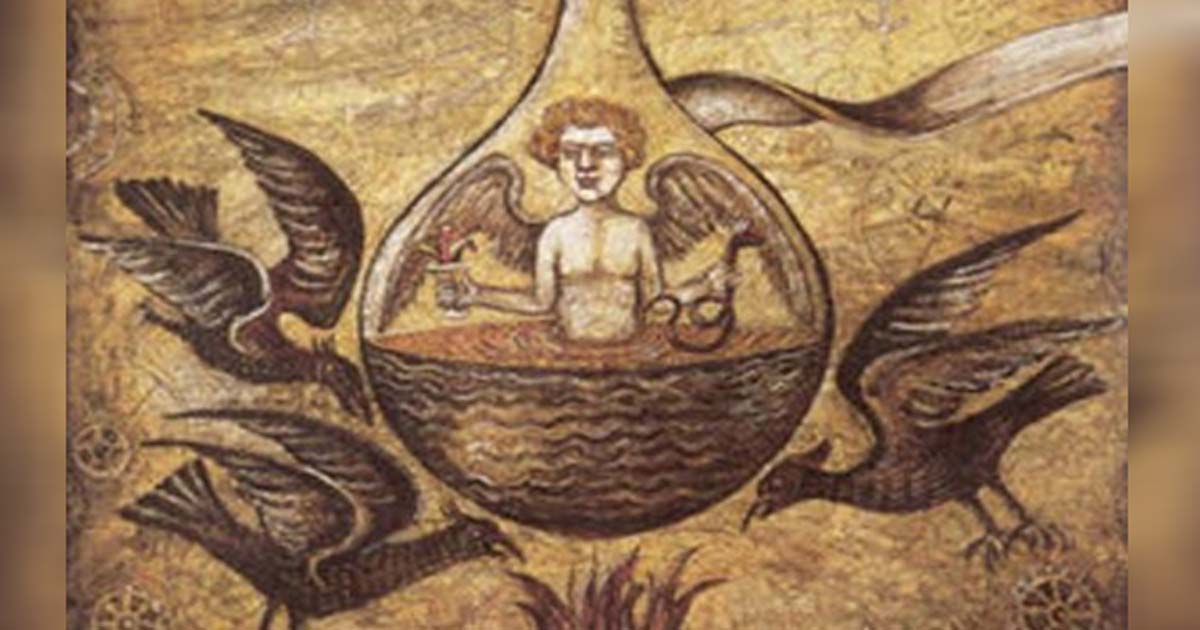Alchemical Recipe for a Homunculus: Sperm + Rotting Meat = Mini Artificial Human
The question of how to create life does not just go back to Mary Shelley’s Frankenstein, when the eponymous character used forbidden science to create life. Humans have been interested in creating artificial life since at least classical antiquity and probably much earlier. One manifestation of this is the idea of the homunculus, a diminutive humanoid creature that was believed to be created through magical means.
The history of the idea of the homunculus combines many topics. It is related to early medical theories about reproduction and gestation, early ideas about spontaneous generation and the origin of life, and even the modern fields of genetic engineering and cybernetics.

The homunculus is a diminutive humanoid creature believed to be created through magical alchemical means. 19th century engraving of Homunculus from Goethe's Faust part II (public domain).
No Egg Involved
In Renaissance medicine, it was believed that the main life-giving force in reproduction came from the man in the form of the semen. The womb was believed to simply be a warm, nutrient-rich vessel for the embryo to grow and be nourished, though the womb was believed to provide the raw materials needed to make an adult. The raw material which the fetus used to mature were considered important in determining what kind of individual the person would become.
This idea that the semen is the main ingredient needed to produce new life in the womb and that the womb is just a passive vessel goes back to Aristotle, who was considered the primary authority on natural science in the Medieval and late Classical worlds.

‘The Alchemist’ by Mattheus van Hellemont (public domain)
Womb Could Be Replaced by a Warm Chamber
Aristotle did not believe that humans could be artificially made outside of the natural mode of sexual reproduction and childbirth, but his ideas did leave open such a possibility. If the human womb was only a vessel for the fetus, then it could be theoretically exchanged with another vessel provided that human semen was used. Other than the sperm, it was thought that all that was needed was a warm chamber and some sort of raw material which could even be rotting meat.
These early ideas about human reproduction have long since been discredited, but they made the creation of the homunculus seem as plausible during the Middle Ages and the Renaissance as cloning is today.
- Mystical Science of Alchemy Arose Independently in Ancient Egypt, China, India
- Alchemy and Immortality – The Tale of Nicolas Flammel and the Lapis Philosophorum
- Spagyric Secrets of The Alchemists: Alchemy as Alternative Medicine
Spontaneous Generation
Another idea that made the creation of the homunculus seem credible was spontaneous generation. Classical, Medieval, and Renaissance philosophers all believed that simple creatures like flies, frogs, and mice could spontaneously arise from inert matter. Flies, for example, were believed to spontaneously form on rotting meat.
The idea of a homunculus spontaneously emerging from inert matter with the addition of semen is very similar to the idea of spontaneous generation which made the idea more acceptable to the mainstream science of the day.
The Homunculus ‘Recipes’
By the early Middle Ages, alchemists and philosophers had begun to compile recipes for making a homunculus. One recipe, described in a text called the Book of the Cow, tells of an elaborate process where a female animal, either a cow or ewe, had to be artificially inseminated with a mixture of semen and a type of phosphorescent mineral and then beheaded when the soon-to-be homunculus was born. After the homunculus was born, it would be fed blood. Other recipes required a female monkey or a mare instead.
The homunculus was believed to have supernatural powers such as the ability to control the motion and appearance of the moon and allow humans to transform themselves into sheep and cows. Fluids from the body of the homunculus were believed to endow the maker of the homunculus with the ability to walk on water among other supernatural abilities.

Homunculus in the Vial. Illustration of Johann Wolfgang von Goethe, Faust. Part Two, Act II, laboratory, 1899 (public domain)
Sperm + Rotting Meat = Humanoid Creature
One recipe, proposed by the 15 th century alchemist Paracelsus, instructed the alchemist to artificially inseminate a horse and allow the semen to putrefy within the womb. He also believed that a homunculus could be created by simply putting sperm in a sealed container with material such as rotting meat or even manure! His instructions as provided in his text De Natura Rerum are as follows :
“Let the Sperm of a man by itself be putrified in a gourd glasse, sealed up, with the highest degree of putrefaction in Horse dung, for the space of forty days, or so long untill it begin to bee alive, move, and stir, which may easily be seen. After this time it will be something like a Man, yet transparent, and without a body. Now after this, if it bee every day warily, and prudently nourished and fed with the Arcanum of Mans blood, and bee for the space of forty weeks kept in a constant, equall heat of Horsedung, it will become a true, and living infant, having all the members of an infant, which is born of a woman, but it will be far lesse. This wee call Homunculus, or Artificiall [Man?]. And this is afterwards to be brought up with as great care, and diligence as any other infant, until it come to riper years of understanding. Now this is one of the greatest secrets that God ever made known to mortall, sinfull man. For this is a miracle, and one of the great wonders of God, and secret above all secrets, and deservedly it ought to be kept amongst the secrets until the last times, when nothing shall be hid [the apocalypse], but all things made manifest.” Paracelsus (via Sandrovigius), De Natura Rerum. Of the Nature of Things.

Portrait of 15 th century alchemist Paracelsus (public domain)
An Artificial Human
Part of the idea of creating a homunculus was creating an artificial human which makes it comparable to the Jewish tale of the golem which could be created from dust by an especially righteous rabbi. There was opposition by some leaders in the church to the making of homunculi since it was considered playing God and because it was thought wrong to create an intelligent, human-like creature just to be a servant.

The golem is first formed in the shape of a human being. Illustration of a golem by Philippe Semeria. The Hebrew word for Truth, one of the names of God, is written on his forehead. (CC by SA 3.0)
Homunculus Ethics
In this way, the narrative of the homunculus mirrors modern debates about genetic engineering and cybernetics. Modern “alchemists” endeavor to make “homunculi” from genetic modification and cybernetics. Many objections to these modern enterprises are very similar objections to the creation of homunculi, particularly the debate over whether homunculi could be considered full persons.
Homunculi were considered powerful but of limited intelligence and reasoning ability, thus they were subhuman and could be enslaved. Not everyone agreed that homunculi were slaves by nature though and some insisted that homunculi must have rational souls.
This mirrors a similar debate today, namely how should genetically modified individuals and AI’s be treated? Can they be equivalent to genetically baseline, biological humans? Should they be given the same rights as humans? Do they have souls? The strange idea of the homunculus is surprisingly relevant today as the dreams of yesterday’s alchemists, artificial life, become the real inventions and creations of today’s scientists and engineers.
Top image: Alchemical illustration of a Homunculus in a vial (new-moster.wikia.com)
By Caleb Strom
References
“Homunculus: The Alchemical Creation of Little People with Great Powers” by DHWTY (2015). Ancient Origins. Available at: http://www.ancient-origins.net/artifacts-ancient-writings/homunculus-alchemical-creation-little-people-great-powers-002928
Snow, Kathleen R. "Homunculus in Paracelsus," Tristram Shandy", and" Faust"." The Journal of English
and Germanic Philology 79.1 (1980): 67-74.
Campbell, Mary Baine. "Artificial men: Alchemy, transubstantiation, and the homunculus." Republics of
Letters: A Journal for the Study of Knowledge, Politics, and the Arts 1 (2010): 4-15.
LaGrandeur, Kevin. "Ancient Definitions of Personhood and Difficult Social Precedents: The Homunculus,
the Golem, and Aristotle." Journal of Evolution & Technology 24.3 (2014).

















